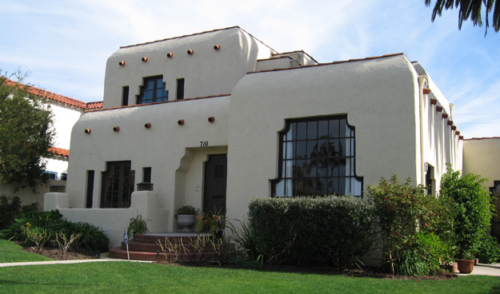Worrell “Zuni House”

- Known As
- Mayan Revival, Pueblo Revival
- Architect
- Robert Stacy-Judd
- Built
- 1926
- Designated
- March 10, 2003
The 1920s were an exuberant period in Southern California architecture. During this time the region underwent explosive population growth and architects worked overtime to devise desirable homes for residents. For the public and architects alike, “desirable” often meant houses with exotic, historic, or romantic qualities. To achieve these qualities architects looked to sources as diverse as ancient Babylon, Tudor England, and China, to name just a few. The region’s burgeoning film industry, feverishly manufacturing visual fantasies of every sort during this era, helped spur on this eclecticism. The result was that architects of the period were often versed in many different “revival” styles, frequently mixing elements from different traditions to create memorable effects.
The landmark at 710 Adelaide Place draws inspiration from two of the revival styles popular in the 1920s—Pueblo Revival and Mayan Revival. Its architect, Robert Stacy-Judd, strongly favored pre-Columbian forms, believing they were highly adaptable to the region. Indeed, Stacy-Judd felt that traditional Native American modes of building “should form the basis for a true American style in the future.” His architectural legacy includes a number of extraordinary structures in this vein, including the wildly ornamented Aztec Hotel on Route 66 in Monrovia.
In the Worrell “Zuni House,” built only a year before the Aztec Hotel, Stacy-Judd opted for a much more restrained interpretation of pre-Columbian forms. Here cube-like shapes are combined and stacked to suggest the stepped-back, multi-storied communal dwellings of the Pueblo peoples of Arizona and New Mexico (Zuni, Hopi, etc.). The architect designed the exterior walls to resemble adobe, particularly in the softened, rounded corners near the rooflines. As on Pueblo dwellings, waterspouts punctuate the façade and serve to drain the typically flat roofs. Departing from a straightforward Pueblo Revival look, however, Stacy-Judd employed Mayan profiles for the principle windows. The arch leading to the front door is of a similar shape. The overall effect is unique. As Stacy-Judd himself wrote about this house, “I was at a loss to designate the type of architecture but it has come to be known as the ‘Zuni’ type.”
This residence has housed a succession of families over the decades. It was also home to the renowned composer Ferde Grofe in 1947 and 1948. Initially constructed as a duplex it was converted to a single-family house sometime between 1940 and 1950. In the 1990s an addition was made to the rear second story and an earthquake eliminated a chimney. More recently a second story has been added to the detached garage.
Located on a quiet residential spur of Adelaide just off Seventh Street, the house ably represents an imaginative phase of Southern California architecture. Fittingly, its neighbors include examples of several other revival styles, as well as more modern dwellings, making this small street a microcosm of the region’s eclecticism that frames this landmark just perfectly.
Sources:
- David Gebhard. Robert Stacy-Judd: Maya Architecture and the Creation of a New Style. Santa Barbara: Capra Press, 1993.
- David Gebhard and Robert Winter. Los Angeles: An Architectural Guide. Salt Lake City: Gibbs-Smith, 1994.
- Cyril M. Harris. American Architecture: An Illustrated Encyclopedia. New York: W.W. Norton, 1998.
- Sam Hall Kaplan, LA Lost & Found: An Architectural History of Los Angeles. New York: Crown Publishers, 1987.
- Charles Moore, Peter Becker and Regula Campbell. Los Angeles: The City Observed. Santa Monica: Hennessey & Ingalls, 1998.
- Santa Monica Historic Resources Inventory, 1985-1986. City of Santa Monica, Building and Safety Department.
- Santa Monica Landmarks Tour. Santa Monica, City Planning Division, 2004.
- Staff Report on 710 Adelaide Place, Worrell Residence. City Planning Division, Santa Monica.